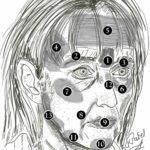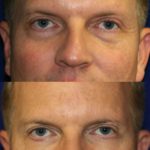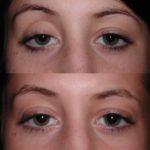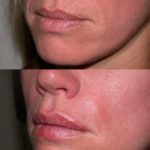ADVANCED DERMAL FILLERS
Advanced Dermal Fillers
NO PAINFUL NERVE BLOCKS
MINIMAL DOWNTIME
NATURAL LOOKING RESULTS
As we age, the effects of gravity, sun exposure and facial volume loss contribute to the development of facial wrinkles, folds, hollowness and sagging. With the advent of modern cosmetic medical techniques, more and more people are opting for non-surgical facial enhancement procedures to correct these issues. Dermal fillers are at the forefront of this revolution.
Dermal Fillers for facial volume loss and augmentation-Actual patients (please click on the image).
Dermal fillers are used commonly in the following facial areas:
- Non surgical nose job (non-surgical rhinoplasty)
- Lip augmentation
- Cheek Augmentation
- Tear Troughs (dark circles around eyes)
- Naso-labial folds
- Vertical lip lines (smokers lines)
- Marionette lines/jowls
- Chin enhancement
Basic dermal filler treatments can be performed by properly trained surgeons with due regard to depth, concentration, volume, and, most importantly, technique.
What are dermal fillers or soft tissue fillers?
Dermal fillers are biocompatible gels, which are injected in or under the skin to enhance facial appearance by restoring hydration, facial contours and volume loss. Once in the skin, they also assist in the production of new collagen, improve the natural texture and elasticity of skin and prevent it from sagging.
What are the different types of fillers available today?
There are several types and brands of fillers available in the USA and Europe. They can be broadly divided into 2 main groups:
- Carbohydrate Gel Fillers
- Non Carbohydrate Gel Fillers
Dermal fillers are now the second most popular non-surgical facial rejuvenation procedure in the States, after anti-wrinkle Injections .
Where can dermal fillers be used?
Dermal fillers can be used in the following areas:
- Cheeks (Cheek bone augmentation)
- lips (to increase volume and projection)
- Nose (Non surgical nose bridge augmentation)
- Tear troughs (hollowing around the eyes)
- Naso-labial folds
- Vertical lip lines (smokers lines)
- Marionette lines/jowls
- Chin (To improve projection and shape)
- Jawline (To enhance jaw definition)
- Temples (to improve hollowing)
- Brows (to help lift the brows)
- Fine lines and wrinkles in the skin (by adding moisture)
What does treatment with dermal fillers involve?
Treatment usually involves the application of a local anaesthetic cream or local infiltration of anaesthesia to the treated area. Dermal filler gel is comfortably injected into the area once its numb. Treatment times vary depending on the amount of dermal fillers required and the area treated, but generally takes about 15 to 45 minutes. After treatment, it is possible to apply makeup, and to go about your normal activities. Patients are advised to refrain from heavy exercise and excessive alcohol as these factors can increase the risk of bruising. Treatment with dermal fillers sometimes does take more than one session to achieve the best results. The first treatment lays the foundation for the subsequent treatments, and future treatments allow for any adjustments to be made. The initial treatment typically requires the greatest volume of filler. Following this, we typically are only required to perform top-ups to maintain the desired long-term outcome.
Is the dermal fillers procedure painful?
Dermal fillers treatment usually requires some form of anaesthesia. Our doctors have developed special anaesthetic techniques to make the procedure virtually pain/discomfort free. This includes vibrational anaesthesia device, topical numbing cream and inhalation anaesthesia gas.
We are often told by patients who have had fillers done elsewhere before, that our injecting techniques are by far the least painful.
Are dermal fillers safe?
There are very few risks associated with dermal fillers when used by an experienced doctor who knows the facial anatomy well. Allergic reactions and major vascular trauma are extremely rare. Dermal fillers have been used for cosmetic reasons for over 20 years. Minor side effects include temporary swelling and bruising at the site of injection.
What is the downtime?
Generally, there is minimal downtime and most people return to their normal activities later in the day. The downtime is usually due to swelling or bruising, which can be easily camouflaged by makeup in most cases. Fillers in the lips tend to cause more swelling in patients 50 years of age and above.This may last for up to 72 hours in some cases but then settles very nicely.
When will I see the treatment results?
Results with dermal fillers are usually visible immediately after the treatment. However, these results improve over next two weeks.. This is because fillers attract moisture and “mature” after they are injected in the skin. There can be some swelling immediately after the treatment. This will subside within a few days. Bio-stimulatory fillers tend to work over a period of several weeks and require 3 or more treatment sessions before the results are visible.
How long do dermal fillers last?
This depends upon the type of dermal filler used, its consistency and the treatment site. Most Carbohydrate Gel fillers last between 6 to 12 months. There is a tendency for fillers to last less in people who are smokers, have high metabolism, are actively trying to loose weight, are on carbohydrate restricted diet or are engaged in vigorous physical exercise programs.
Are there any alternative treatments available that deliver similar results as dermal fillers?
Fat grafting is an excellent and longer lasting alternative to dermal fillers. Fat cells exist naturally in the body and contain stem cells. We offer the latest Micro Fat Grafting Injection treatment for facial volume loss and rejuvenation. To read more about Fat Grafting, please click here.
What can I do to prepare myself for this treatment?
Bruising is the most common side effect of any injection-based treatment. To minimise this, it is best to avoid anti-inflammatory drugs such as aspirin (unless for medical reasons) ibuprofen, fish oil supplements, green tea, garlic, ginkgo and other herbal products for a week prior to the procedure. All these products are known to thin the blood and increase its clotting time, hence increasing the risk of bruising. Please inform our staff if you are using any medication at the time of your initial consult.
Alcohol also increases the risk of bruising and its consumption should be kept to a minimum the day before your procedure. We also encourage our clients to commence arnica tablets a few days before treatment. Arnica is a herbal supplement and is known to reduce the risk of bruising. It is available over the counter in most pharmacies.
(Note: If you have a history of cold sores, please notify us at the time of initial consultation as soft tissue filler treatment can cause a cold sore flare-up.You may be required to take prophylactic anti-viral medications prior to any treatment).
Questions?
Please come and see us so we may assess the contours that may be improved: we will guide you to get the maximal improvement with the minimum of fillers: always under-correct areas to prevent the “over-filled” look!
(801) 413-3599 (phone/text)
E: in**@pa*****************.com
bckpatel.info
Site of the “English Surgeon”. Dr. BCK Patel MD, FRCS, Salt Lake City, St. George, Layton, Orem, Mid-Town, London
Quick Enquiry
Short on time? Simply send your enquiry here and we will get back to you with more information.
www.englishsurgeon.com: Site of the "English Surgeon" website. Dr. BCK Patel MD, FRCS, Salt Lake City, St. George, Layton, Orem, Mid-Town, Utah; London, England
Originator of London Blepharoplasty, London Facelift, London Browlift, Patel Hammock Lift, SMURF Festoon Correction. Created by Patel Plastic Surgery - Dr. Bhupendra C. K. Patel MD, FRCS
Dr. BCK Patel MD, FRCS 1025E 3300S Salt Lake City, Utah 84106, USA (801) 413-3599 (phone/text) E: in**@pa*****************.com
Dr. BCK Patel MD, FRCS 585 E Riverside Dr Suite 201 Saint George, UT 84790 (435) 215-0014 E: dr********@gm***.com










